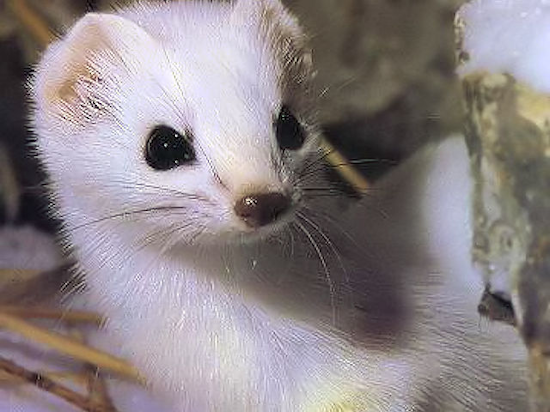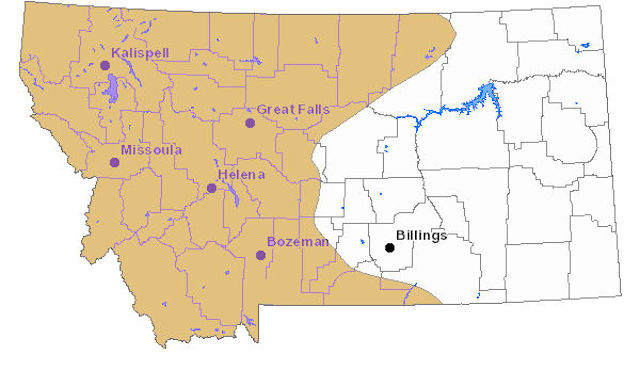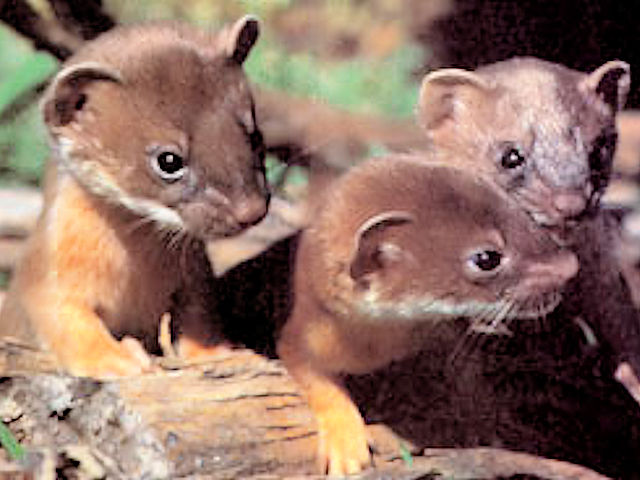Short Tailed Weasel

Other Names: Ermine, stoat
Status: Winter pelts of value when fur prices are high. Unprotected predator.
Mustela erminea
Order: Carnivora
Family:
Mustelidae
Identifying Characteristics: Of the three North American weasels is intermediate in size and one of the smallest carnivores in the world. Males distinctly larger than females. During summer fur is dark brown with white underparts, white feet, and white line down hind legs. Molts to white during winter, except black tip on tail.
Total length: 7 to 13 inches. Weight: 1 to 6 ounces.
Habitat: Inhabits brushy or wooded areas, usually not far from water. Tends to avoid dense forest. Prefers areas with high densities of small mammals. Most abundant in ecotones.
Food Habits: Although short-tail weasels prey on a variety of small mammals and birds, they specialize in hunting voles.
Life History: Mostly nocturnal but will hunt during the day. Active throughout the year. Dens in ground burrows, under stumps, rock piles, or old buildings. Breeds during summer; 8.5 to 10 month gestation; delayed implantation; young born April or May; one litter per year of 4 to 13 young.
Similar Species: Long-tail weasel - larger, longer tail. Least weasel - smaller, short tail, no black tip on tail. Mink - larger, uniform color.
 Characteristics
Characteristics
The short tailed weasel (Ermine) is noticeably
smaller, with a shorter tail, and varies from 8
to 14 inches long with a 4 1/2 inch tail. They
weigh from 1 1/4 to 5 ounces and are 2 to 3
inches high.
It has a long, slender, muscular body with short legs. The head is small, with beady eyes, small ears and a pointed nose. They move with quick movements and a graceful, bounding gait. Weasels change color with the seasons, and there is no color difference between the sexes. All the senses are well developed in the weasel.
In summer, the short-tailed weasel is dark brown on the back and legs. The chin, throat and undersides of the legs are white or a light yellow. In winter, it is entirely white, sometimes with yellowish stains on the lower abdomen. The tail has a black tip year round.
Life Cycle
The short-tailed weasel females mature at 3 to 4
months and males mature at about one year. The
breeding season is in July. There is a period of
delayed implantation with a gestation period of
9 to 10 months. The period of active pregnancy
is 17 to 23 days.
 Litter sizes varies from four to thirteen, with an
average of six to eight. The young are born in
April or May in nests constructed in underground
dens or hay piles. Mouse nests and burrows are
often used and heavily lined with fine grass and
mouse fur. The male begins to bring food to the
den about 1 month after the young are born. The
young are weaned at the end of 5 weeks and are
able to hunt for themselves by 7 or 8 weeks of
age. The family stays together until late summer
and then disperses. The life expectancy of
weasels is short, probably less than a year,
although they are capable of living as long as 6
years.
Litter sizes varies from four to thirteen, with an
average of six to eight. The young are born in
April or May in nests constructed in underground
dens or hay piles. Mouse nests and burrows are
often used and heavily lined with fine grass and
mouse fur. The male begins to bring food to the
den about 1 month after the young are born. The
young are weaned at the end of 5 weeks and are
able to hunt for themselves by 7 or 8 weeks of
age. The family stays together until late summer
and then disperses. The life expectancy of
weasels is short, probably less than a year,
although they are capable of living as long as 6
years.
Food
Weasels prey on small rodents such as mice,
rats, voles, hares, rabbits, and chipmunks. They
also take shrews, birds, birds eggs, frogs,
bats, insects, earthworms and may occasionally
kill domestic chickens.
The weasel hunts by tirelessly and persistently investigating every small hole, crevice, bush or rock pile it encounters. They will track prey by following their scent trails and generally attack prey by ambushing and pouncing on it. They are very quick and kill by piercing the base of the skull with their teeth. The weasel frequently kills more than it can eat and often caches leftover food. The weasel can consume up to one third of its own weight in a 24 hour period.
Habits
Weasels are curious, alert and bold. They are
persistent hunters who seldom remain long in
their dens and may be abroad hunting at any
hour, although they are usually most active at
night. Weasels are active year round. Weasels
occasionally hunt in pairs but, for the most
part, are solitary except during breeding and
rearing season. They are good swimmers and can
also climb trees. All species emit a strong musk
odor when alarmed, and the weasel may stamp its
feet when annoyed. Weasels may mark their trails
with droppings. Home ranges very from 30 to 400
acres.
Population
Weasel populations often cycle with mouse
populations. Several parasites can infect
weasels, such as guinea worm and kidney worms.
These probably have little impact on the
population.
Weasels are subject to predation from hawks, owls, foxes, coyotes, dogs, cats and man.
In agricultural areas, weasels are more common due to the practice of storing grain which provides ideal conditions for mice.
Habitat
Weasels prefer woodlands or open country with
hedgerows, thickets or fence rows. They are
usually found near water but are not
semi-aquatic as is the mink. They frequent stone
piles, brush heaps, wood piles, hay stacks, log
piles and old abandoned buildings.
The short-tailed weasel inhabits brushy or wooded areas, usually not far from water. It tends to avoid dense forests.
The dens of weasels are shallow chambers about 6 inches underground with two to three entrances and are lined with mouse fur and grass.
Economic Value
The fur of the short-tailed weasel was once
reserved for use by royalty. The fur of the
short-tailed weasel is fine and of good quality
and is used in garments, lining and trim.
Weasels play an important role in helping to control rodent populations.